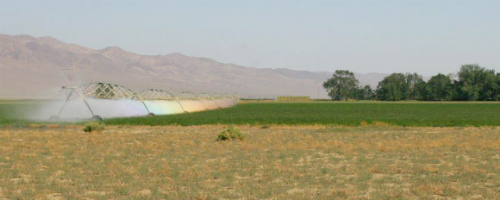How drought’s economic impact on California agriculture is a wake-up call

(Photo Credit: kerinin/Flickr)
The drought of 2014 will cause California’s agricultural economy to take $1.5 billion hit. While a new UC Davis report shows how the sector’s resilience has prevented a more catastrophic number, it also makes the case that agriculture can’t afford the state’s water systems to be run year after year in emergency mode.
With 79 percent of the state sitting uncomfortably in “extreme drought” status, the agriculture industry will suffer its greatest loss of water ever recorded in California, according to the authors of the UC Davis Center for Watershed Sciences study.
The direct cost to agriculture here includes $810 million in crop loss and $500 million to pump groundwater. That drilling for and pumping of groundwater is what is sustaining many crops and a big reason why the $1.5-billion total loss only represents 3 percent of agriculture’s total value in California.
But it’s not sustainable. If the drought keeps going, pulling groundwater next year and the year after would put California in a dangerous spot.
“Failure to replenish groundwater in wet years will continue to reduce groundwater availability to sustain agriculture – particularly more profitable permanent crops – during California’s frequent droughts,” said the report.
What California should be doing besides, of course, conserving more? The study suggests shoring up and enhancing the features that will get farmers and ranchers through this year’s drought: reliable groundwater and the ability to use water markets to transfer water to high-value crops.
The study’s results, which mirror preliminary results back in May, merely reinforce that, while the economic impact right now may be minimal, the economic story of shoring up California’s water supply doesn’t end there.
Which makes the 11 Summit ideas for sustainably responding to the drought so relevant to what the UC Davis researchers have concluded. The state needs to be looking downstream.
Emergency measures and long-term water projects, including those related to groundwater management, should be comprehensive and integrated with other water needs, and have incentives for strategies that produce some clear results.
Along the lines of the report’s suggestion of enhancing California’s water trade market, one of the Summit ideas includes streamlining the regulations around water transfers, which sometimes can take several months and many signatures to get approved.
As water bond debate picks up steam again and the drought drags on, it’s imperative that California not manage watersheds, stormwater, groundwater aquifers, and water supply systems as separate issues anymore, but does promote projects that protect the environment, support regional economies, and increase opportunities for all Californians at the same time.
To win voters’ approval, any water bond on the November ballot will need to show how it’s going to pay for California’s water future wisely. Some of those voters are farmers and ranchers, and all voters benefit from a strong agricultural economy here and from reliable water at the ready.
Originally published in CAeconomy.

Dr. Ansari on health care’s future amid demographic shifts
Original story on permanente.org During a recent CEO workgroup panel, “Advancing Your Culture…
December 23, 2024
Drs. Hoberman and Nguyen on preparing for health care AI
Original story on permanente.org Many questions surround the advancements of artificial intelligence in…
October 30, 2024